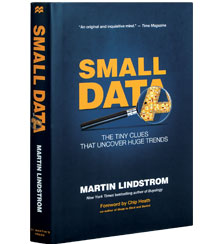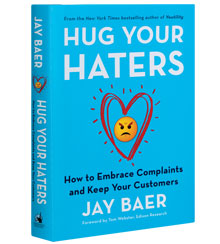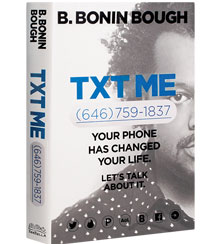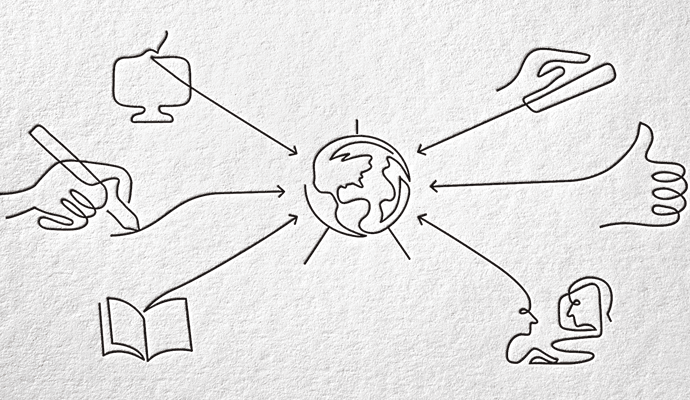Best Business Books 2016: Marketing
Big Marketing Gets Personal
Martin Lindstrom
Small Data: The Tiny Clues That Uncover Huge Trends (St. Martin’s Press, 2016)
* A TOP SHELF PICK
Jay Baer
Hug Your Haters: How to Embrace Complaints and Keep Your Customers (Portfolio/Penguin, 2016)
B. Bonin Bough
TXT ME (646) 759-1837: Your Phone Has Changed Your Life. Let’s Talk About It. (BenBella Books, 2016)
The last 15 years have been expansive ones for marketers. Digital media has exploded what used to be a rather static business, ushering in the era of big data, discovering mother lodes of customer insights, and offering an ever-increasing number of platforms, devices, and media channels where marketers can reach their customers.
So it’s a bit unexpected that, to quote a 1960s ad for the Volkswagen Beetle, this year’s best business books on marketing tend to “think small.” True, these three books do so in wildly different ways. But they all seem to argue that even with the buckets of data now sitting on servers at the world’s biggest corporations, we also need to understand and relate to consumers at the micro level. This can mean examining teenagers’ closets for clues to who they really are, responding personally to each and every customer complaint, or looking at how that most personal device — the smartphone — is changing what it means to be a person and a marketer in 2016 and beyond.
Small Data: The Tiny Clues That Uncover Huge Trends, by Martin Lindstrom, is the year’s best business book on marketing for two reasons. It’s a potent, example-filled counterbalance to marketing’s current love affair with big data, and it’s such an entertaining read that even people who aren’t in marketing should consider picking up a copy.
If big data — by its name alone — implies that it holds the answer to everything, Lindstrom, who over the years has worked with Disney, McDonald’s, Lego, Nestlé, and Pepsi (to name a few), dispels that belief when he says, frankly, it ain’t all that. “For all the valuable insights big data provides,” he notes, “the Web remains a curated, idealized version of who we really are. Most illuminating to me is combining small data with big data by spending time in homes watching, listening, noticing and teasing out clues to what consumers really want.”
Part detective story, part anthropological study, and part travelogue, Small Data follows Lindstrom to Russia, China, Brazil, Saudi Arabia, Austria, and other locales as he tries to answer questions including: Why don’t the Chinese use bedspreads? What is the significance of Russians’ love of refrigerator magnets? And just what are teenage girls in Europe doing between 6:00 and 6:30 every morning? Lindstrom refers to what he does as “subtext research,” seeking clues to people’s lives that usually go unarticulated in pools suffused with big data, and everywhere else.
In answering each of the above questions, Lindstrom is striving to solve a marketing problem. And it is a thrill for readers to follow him from initial research to solution. In the case of the teenage girls, Lindstrom had been hired to help the European clothing retailer Tally Weijl, which was having difficulty identifying trends and making shopping in its stores enjoyable. What he eventually discovered — by poring through phone records — is that teenage girls were texting each other pictures of potential outfits to wear to school in the early hours of the morning, and that finding created a strategy for Tally.
The route to this insight relied on much more detective work than trying to find patterns in phone bills. The girls had told Lindstrom only that early in the morning they were “getting ready for school.” But he observed other behaviors that pointed him to a deeper understanding of what they meant. He noticed that girls of that age no longer seemed to use oil-based hand creams. Was it because such creams made messes of smartphone screens?
Then there was the matter of the size of the holes in the shampoo bottles. Previous work for a European shampoo manufacturer had taught him there was a correlation between the size of the holes in shampoo bottles and the length of people’s showers. Smaller holes, shorter showers. And the teenage girls’ shampoo bottles fit the “small hole” pattern. They weren’t spending early mornings taking long showers.
Cue the phone bills — and the answer to the mystery.
Lindstrom then recommended that Tally Weijl simulate girls’ early morning rituals at its stores by creating “click and mortar” dressing rooms. Each dressing room comes with an Internet-connected full-length mirror; girls can log in to Facebook, take selfies in the clothes they are trying on, and set up a voting session with their friends to figure out what they should buy.
Given the author’s extreme facility with picking up on details that most of us would miss, Small Data leaves the reader with the nagging feeling that the bar is too high for most of us to become superior miners.
Fortunately, Lindstrom closes the book by revealing his process, seven steps that can lead marketers all the way from data collection to marketing concept. Although there’s no guarantee that marketing practitioners who embrace Lindstrom’s method will become as facile at it as he is, letting readers in on his technique was crucial. If, as Lindstrom says, “big data and small data are partners in a dance,” it’s best not to leave those searching for clues in small data completely flat-footed.
Haters Gonna Love
By contrast, Jay Baer’s Hug Your Haters: How to Embrace Complaints and Keep Your Customers may not startle readers with its confounding ability to make two plus two equal five. At times, in fact, the book seems prosaic in comparison with Small Data. But simplicity can be a virtue. This book is one of 2016’s best precisely because it’s a straightforward, pragmatic look at how to engage with angry customers.
As he did in his previous book, 2013’s Youtility: Why Smart Marketing Is About Help Not Hype — which I also picked as a best business book on marketing for strategy+business — Baer is looking to be practical. He often uses a playbook-style approach to help marketers learn how to reach out to aggrieved customers, no matter what channel they are using to voice their problems. In so doing, he codifies not only how to handle customers through one-on-one channels, but how to navigate the Wild West of angry tweets, whiny Facebook posts, and irate Yelp reviews that have made many a marketer wonder how, and even whether, they should engage.
Baer’s major organizational insight is that there are essentially two types of haters: onstage haters, who use social media as their primary complaint venue, and offstage haters, who prefer more private channels, like email or phone. (He concedes there is a third type — crazies — and, yes, he outlines a strategy for dealing with them too.)
However, as Baer points out, what differentiates the two major hater groups isn’t just the channel they choose. They are actually motivated by somewhat different impulses and are looking for different outcomes. In a helpful pullout in the middle of the book, a chart that Baer calls the Hatrix, he teases out some of their differences. Onstage haters complain somewhat more than offstage haters, and tend to be younger and more social media savvy; however, they also have a lower expectation than offstage haters of actually receiving a reply. Although 91 percent of offstage haters expect a reply to an email complaint, only 42 percent of onstage haters think a company will respond to a complaint they make on social media.
Some of this data seems obvious. As the book points out, “In the same way that bumper stickers are the most shallow form of political expression, social media grousing is the thinnest form of customer complaints.”
But therein lies opportunity. Baer’s strongest suggestion is that companies take advantage of moments to engage with customers that are hidden in plain sight. When companies respond to onstage haters in channels where a reply isn’t expected, it can create advocacy — i.e., situations in which customers help promote the company and its services to their peers and the public. For example, companies that adopt a strategy of responding to customers on boards and forums can see a 25 percent boost in advocacy; the figure is 20 percent for social media. Offstage haters will advocate too, but the bump is much smaller.
As Hug Your Haters points out again and again, “customer service is now a spectator sport,” so responding in onstage venues produces a hugely positive impact — by solving one person’s problem in front of an audience.
As Hug Your Haters points out again and again, “Customer service is now a spectator sport.”
Much of the book is painted in broad strokes, but its examples provide nuance. Baer serves up truly creative ways that companies large and small have embraced their customers.
Restaurant chain Le Pain Quotidien gives its haters a restaurant gift card, and asks them to visit another of its restaurants in the area and tell the company how it’s doing. The Dutch airline KLM, when barraged with customer queries during mass flight cancellations stemming from the 2010 volcanic eruption in Iceland, answered every single one of them. It has kept its strategy of replying to every customer up to this day. Online photo company Shutterstock employed a similar strategy during a 2015 service outage, and saw its users openly advocate for the company because of how it handled the situation.
Most companies spend the majority of their marketing efforts on customer acquisition, i.e., gaining new customers. As Hug Your Haters emphasizes, working on customer retention may be a more profitable strategy. “Hugging your haters gives you the chance to turn lemons into lemonade, morph bad news into good, and keep the customers you already have,” the book says — one customer at a time.
Text Me Maybe
Yes, the book TXT ME (646) 759-1837: Your Phone Has Changed Your Life. Let’s Talk About It. is audacious, as almost any book that puts a real phone number on the front cover would be. It’s the number of the book’s author, B. Bonin Bough, whom I texted at that number to get an advance copy of his book.
The brashness of the title threw me off at first. Wouldn’t it follow that the book itself is a little loud and obnoxious? So imagine my surprise in discovering that TXT ME is actually an engrossing meditation on how the mobile phone has altered us. If that sounds like hyperbole, try to think of how you navigated your life before you got your smartphone. It’s hard to remember, isn’t it? (Disclosure: I do some work for the Mobile Marketing Association, of which Mondelez, mentioned below, is a member.)
TXT ME isn’t a marketing book per se, but more of an insider’s tour of the smartphone revolution. It may seem unlikely for a guy who markets Ritz crackers and Trident gum for a living — Bough is the former chief media and e-commerce officer at Mondelez International who now hosts the CNBC show Cleveland Hustles — to be described as a smartphone insider. But Bough has made his name from his ability to merge marketing and technology for conventional brands in some truly extraordinary ways. One example: Mondelez’s Trending Vending machine at 2014’s SXSW Interactive, in which attendees could get a customized, 3D-printed Oreo cookie whose “recipe” came from that moment’s trending Twitter topics.
TXT ME is less about mobile technology than about people’s relationship with it — and Bough knows how to describe that relationship with a depth of understanding that even most of his fellow tech-heads probably can’t. Take this summation of the “language” particular to Facebook: “Over time we’ve learned to read between spaces, to interpret the presence or absence of a ‘like,’ to exhume hidden meanings in photos and videos — in short, to decipher the site’s contemporary cave drawings while hoping we have enough self-awareness to be more genuine about the way we present ourselves on our own home pages.”
Marketers may flip directly to the chapters that have to do with business, and that’s OK. They alone are worth the price of admission. In the chapter dealing with retail, which begins with the hard truth that gum sales have dropped because people standing in the checkout line are looking at their phones, Bough outlines a future scenario. He imagines a time when online and offline retail experiences are not segregated “in an either/or way” but rather flow into one another. His dreamscape, in which grocery store shoppers dock their phones in their shopping cart, which then loads with information on store promotions or recipes attuned to their interests, is futuristic — but it also sounds like something that will be realistic in a few years’ time.
Bough’s extended riff on how mobile might change the experience of attending a sports event is another highlight. He pictures a sequence in which a few days before game time, our phones automatically populate with background stats and point us to team merchandise. On game day, our devices send alerts about seat upgrades and tell us about friends who are also in attendance. And those ideas are just for starters. It’s a peek inside another mind brimming with clear-eyed possibilities.
In short, TXT ME will make readers look at smartphones differently, and have them contemplating just how profoundly a little device has changed things.
It’s worth highlighting that each of the approaches in these books involves going small, or narrowcasting in some way. The conversation in these three books about marketing is largely about what happens on handheld screens. They barely mention the larger screen that has been — and will continue to be — vital to marketing: television. The broadcast television commercial isn’t dead by any means. Billions of dollars will be spent this year on network and cable advertising. In many ways, however, the focus has shifted. For major brands, TV is still a way to lay the foundation for a brand. But, as these books point out, true differentiation comes not from pitching a single message to the masses but from sweating the small stuff and dealing with customers as individuals.
Reprint No. 16416
Author profile:
- Catharine P. Taylor has covered digital media since 1994, writing for publications including Adweek and Advertising Age. She also wrote the weekly Social Media Insider column for MediaPost for seven years and currently writes about marketing for strategy+business. Additionally, she is a program director for the Conference Board, managing some of its marketing-focused events.








